In the realm of culinary creativity, designing a bespoke cheeseburger goes beyond simply combining ingredients; it involves a careful balance of nutritional content, flavor profiles, and cost considerations. This article explores the mathematical foundations behind custom cheeseburger design, including techniques such as linear programming for optimizing macronutrient distribution, constraint satisfaction to adhere to dietary restrictions, and flavor balancing through weighted averages. Whether aiming for a high-protein, low-fat option or a burger that hits specific calorie targets, mathematics plays a crucial role in crafting the perfect cheeseburger tailored to individual preferences and nutritional goals.
Designing a bespoke (customized) cheeseburger involves creating a burger with specific nutritional or taste profiles by selecting and combining different ingredients. The math behind such a design includes optimizing the quantities and types of ingredients to achieve desired outcomes, such as specific calorie counts, protein levels, or flavors.
Mathematical Considerations in Cheeseburger Design
- Ingredient Selection:
- Base Ingredients: Beef patty, cheese, bun, lettuce, tomato, etc.
- Optional Ingredients: Bacon, onions, pickles, sauces, etc.
- Nutritional Targets:
- Calories: How many calories should the cheeseburger contain?
- Macronutrient Distribution: Ratio of proteins, fats, and carbohydrates.
- Specific Nutrient Goals: For example, maximizing protein or minimizing fat content.
- Optimization:
- Linear Programming: This mathematical technique can be used to optimize the ingredient mix. For example, you might want to maximize protein while keeping calories under a certain limit. Linear programming can help find the optimal amounts of each ingredient to use.
- Constraint Satisfaction: If you have specific dietary constraints (e.g., low sodium, gluten-free), you need to ensure that the ingredient mix adheres to these rules.
- Flavor Profile Design:
- Weighted Averages: You can create a desired flavor profile by assigning weights to different ingredients based on their contribution to flavor, such as sweetness, saltiness, umami, etc.
- Balancing: The math here involves balancing flavors so that no single taste overwhelms the others.
- Cost Optimization:
- Cost per Ingredient: Each ingredient has a cost, and you might want to minimize the overall cost while achieving your nutritional and taste goals.
- Budget Constraints: You can set a maximum budget for the cheeseburger and use mathematical optimization to stay within this budget.
Example Scenario
Let’s say you want to design a cheeseburger with the following constraints:
- Total Calories: 600 kcal
- Protein Goal: At least 30g
- Fat Limit: No more than 25g
- Carbohydrates: Around 50g
Using mathematical optimization, we can select the amounts of each ingredient (e.g., beef, cheese, bun, bacon) to meet these constraints.
Mathematical Formulation
This problem can be formulated as a linear programming problem:
- Objective: Minimize or maximize a particular nutritional aspect (e.g., minimize cost, maximize protein).
- Constraints:
- Total Calories≤600\text{Total Calories} \leq 600Total Calories≤600
- Total Protein≥30\text{Total Protein} \geq 30Total Protein≥30
- Total Fat≤25\text{Total Fat} \leq 25Total Fat≤25
- Total Carbohydrates≈50\text{Total Carbohydrates} \approx 50Total Carbohydrates≈50
The optimization would involve adjusting the quantities of each ingredient to meet these constraints while achieving the desired flavor profile and nutritional goals.

Leave a Reply